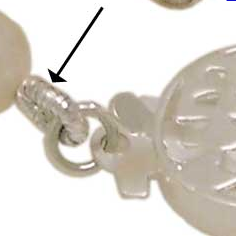I recently had an interesting discussion with a woman on a pearl and bead stringing forum about the benefits of French wire. She was responding to a quick post I had made suggesting I’m not a big fan of French wire.
Now, I want to say immediately that this woman is clearly an expert in her area which is pearls and pearl and bead stringing and her comments on French wire were right on point.
French wire, of course, is the tiny piece of coil that covers the thread at the point where it slips around the clasp.
She asserted, quite rightly, that French wire provides important protective properties. It helps prevent the silk from rubbing against the clasp thereby preventing possible fraying. She also asserted, again quite rightly, that French wire can prevent dirt accumulating on the thread at the clasp where it is handled the most.
As you may have guessed, I’m not a huge fan of French wire. In clumsy hands, the coil it makes at the clasp draws attention to itself, usually by being too large. Moreover, it’s sometimes difficult to match the color of the wire to the color of the clasp, if, in one example, you use gold in two different karats. The coil itself can pull apart. Finally, and this is a purely subjective opinion, I think French wire looks and is a little old-fashioned. In fact, it’s my experience that while older clients sometimes insist on French wire, younger clients don’t.
I do, however, see its benefits when used with silk.
Silk is a lovely thread and is available in many different lovely colors. It also possesses one important protective property. Should dirt or grime accumulate at the drill hole, that gunk tends to attach to the silk and is not pushed into the drill hole where it could damage the gemstones. This is especially important with pearls.
So, given that protective property, the use of silk and French wire should be a no-brainer. Right?
Well, not so fast. The problem with silk is that it stretches. Knots pull away from drill holes and result in an unsightly amount of thread showing on the necklace. The stretching problem with silk is in fact so acute that as a general recommendation, the Gemological Institute of America says pearl necklaces strung on silk should be restrung every six months.
Silk, as my discussion partner also mentioned, frays. And over time, white silk discolors into an unappealing yellow.
So the real question is why use silk at all?
There are two issues here.
Silk’s protective properties make it an important option for use with expensive pearls where the owner is interested in providing every level of protection for them. Given the choice, owners of expensive pearls will always opt for silk even with the understanding of the time and cost involved in frequent restringing.
But buyers of less expensive pearls will resist the idea of frequent restringing. And, frankly, most people resist the notion of significant amounts of grime around their necks.
The second issue is the trade-off between design and manufacture, perhaps the central manufacturing issue confronted by pearl and bead stringers. Sometimes the silk is so important to the design of the necklace that you’ll decide to use it and then caution your client about the need for frequent restringing. However, if the thread is not a design element then consider another material.
So, to circle back around to French wire. If you use stronger materials, you don’t need it. If you use silk and plan for frequent restringing, the material won’t have time to fray or discolor thereby rendering the use of French wire purely optional and making it an aesthetic rather than functional choice and many people believe French wire adds a professional and finished look to a piece of jewelry.
I’ve played around with many materials in my career. I discuss the most important on a free video here on the website. You’ll have to use the opt-in form on the home page, but I do hope you’ll feel the information is worth it.


